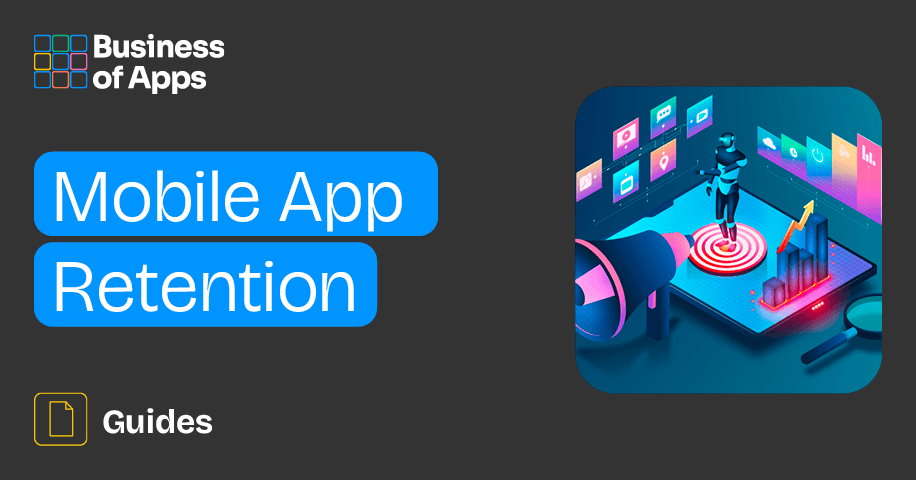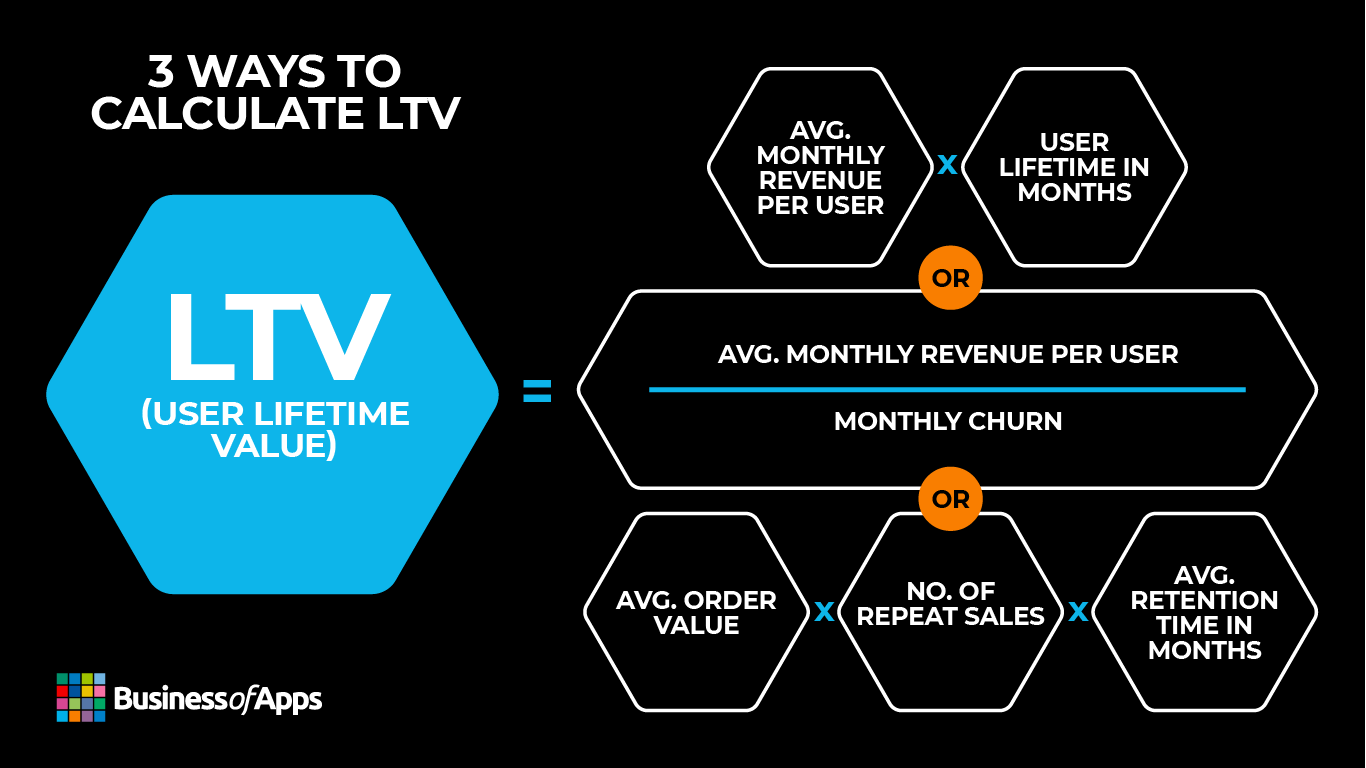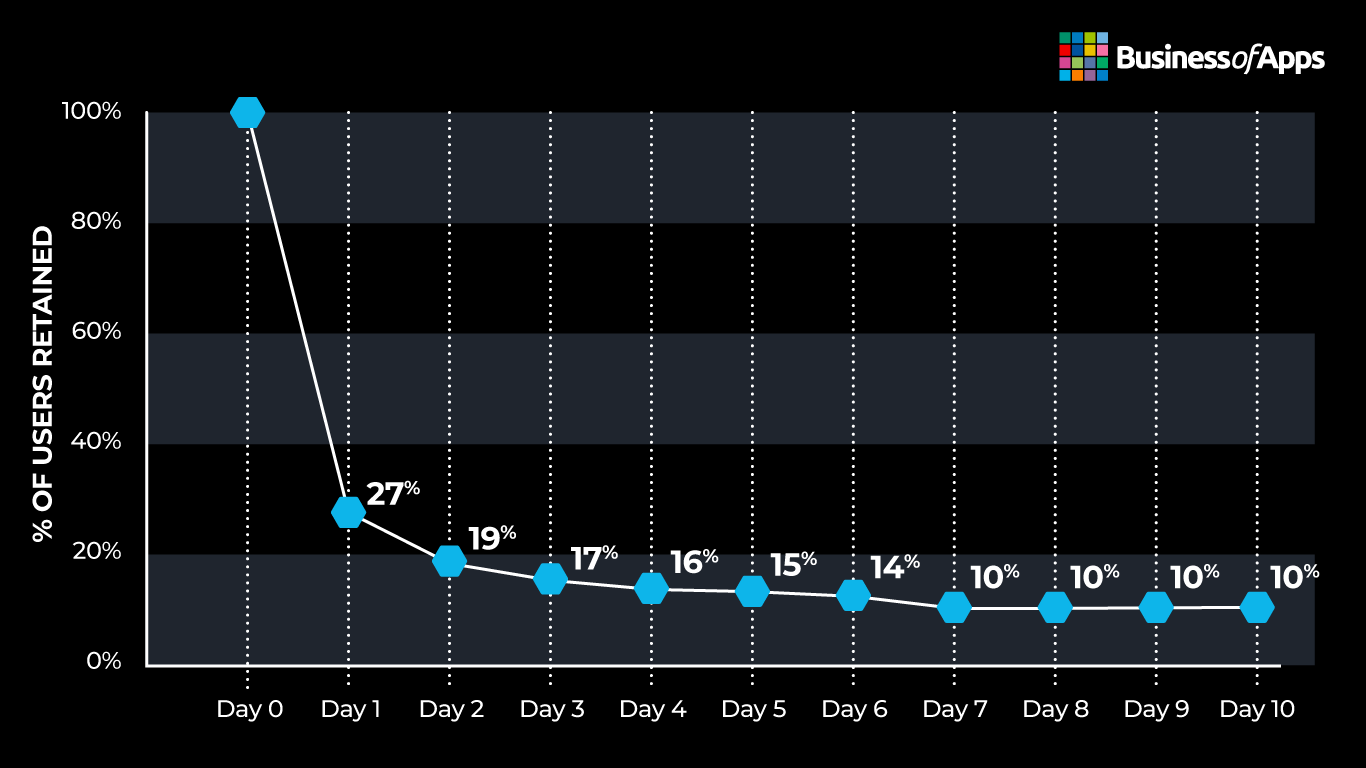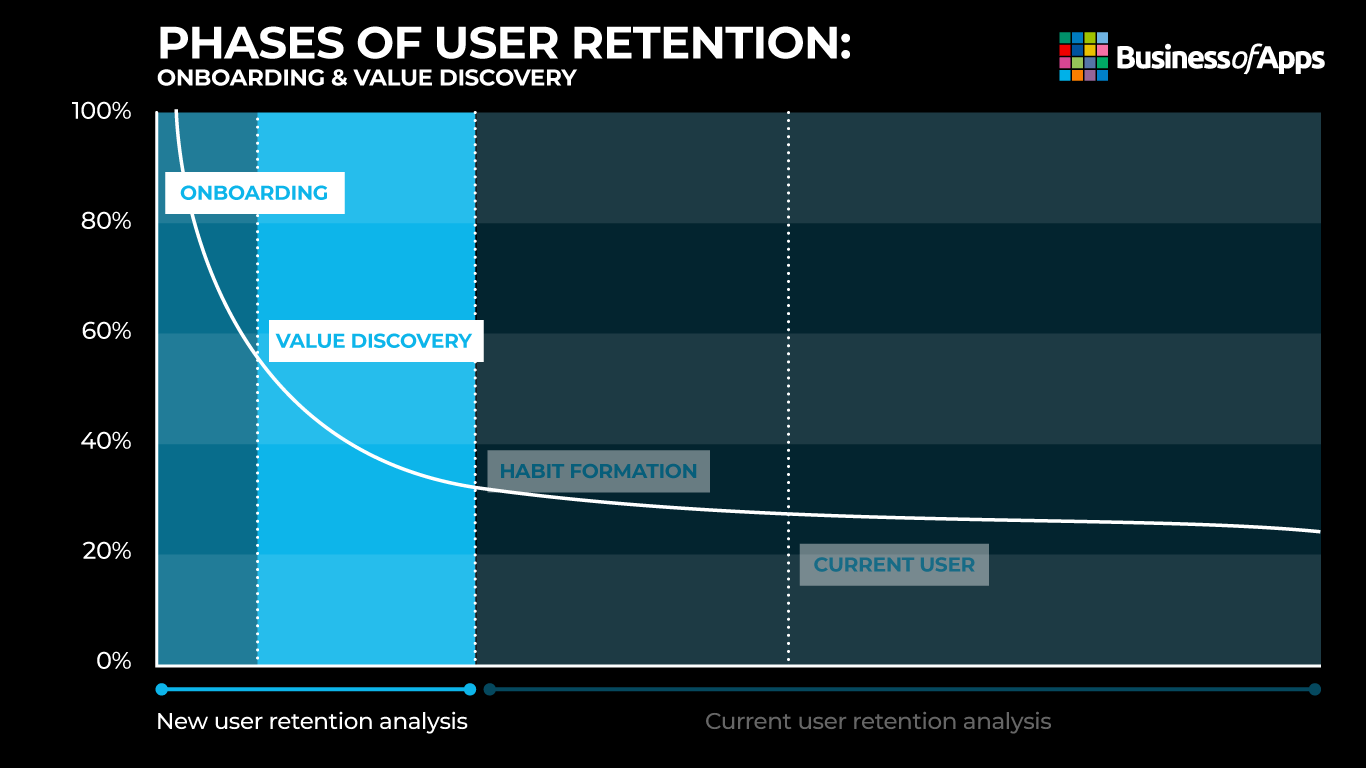
There are many ways to acquire mobile app users — App Store Optimization, influencer marketing, paid ads to name just a few. But what do you do after you have gained all these sweet new users? You need to keep them engaged and active if you are to keep your app profitable and sustain its growth. That is where a good app retention strategy comes in.
Retention rate is an all-important metric for app marketers that helps them understand what percentage of their user base keeps coming back to the app versus how many are churning, or dropping out. Understanding retention is paramount to creating engaging user experiences that keep new users coming and ensures that old users stay locked in.
So, given how important retention is, let’s talk about it. In this guide to mobile app retention, we will define retention and retention rate, discuss its benefits and purposes, and explore the most common strategies for retention. The guide will be accompanied by plenty of data, images, best practices tips, and even expert views, so you can be sure it is a worthwhile read.
Mobile app retention key statistics
- Research into worldwide retention rate shows that the average retention rate across 31 mobile app categories was 25.3% on Day 1, before falling to 5.7% by Day 30.
- Average retention rate Day 1 (iOS) – 25.65%
- Average retention rate Day 30 (iOS) – 4.13%
- Average retention rate Day 1 (Android) – 23.01%
- Average retention rate Day 30 (Android) – 2.59%
- DAU/MAU ratio of around 20% is considered good, with anything above 25% being quite exceptional.
- The average app loses 77% of its daily active users (DAUs) within the first 3 days after install.
- Average Month 1+ churn rate – 55%
- Average Month 3+ churn rate – 68%
- In-app messages are proven to boost retention by 30% when properly implemented.
- On average, owned media (push notifications, email, SMS) Day 30 retention rates experienced 30% higher rates in 2021 compared to user acquisition campaigns.
- 90% of app users who engage with an app at least once a week are more likely to be long-term users.
What is retention?
Retention is most commonly defined as the number of unique users that launched the app at least once during a specific day/week since installation or the total number of users that launched the app for the first time during the selected date range.
In other words, retention is the total number of users still using your app after any given period of time. Retention rates are most commonly measured after Day 1, Day 7, and Day 30.
App Engagement Buyer's Guide
Download our App Engagement Buyer’s Guide, covering all the trends, strategies, and metrics you need to know to ace app engagement in 2025.
An app’s retention rate is then measured by comparing the number of users an app has at the beginning of a given time period with the number of users the app has at the end of that time period.
Mobile app retention rate formula
A high retention rate is indicative of a healthy app that offers its users a positive user experience. In other words, retention is the foundation for an app’s sustained growth and a pivotal part of an app’s user lifetime value (LTV).
On the other hand, a low retention rate shows you that there is some problem with your app that you need to address. When exactly users tend to churn can indicate a variety of problems. For example, high churn on Day 1 can suggest that there are some problems with your onboarding process.
User Retention vs User Acquisition
So, let’s get some things out of the way. Retention isn’t the same as user acquisition (UA), but the two are very closely related.
To retain users, one must first acquire them. However, the strategies needed to acquire users and the ones to retain them aren’t the same, even though they are all part and parcel of an app’s overall growth strategy.
To properly distinguish them, it might be useful to think of acquisition as an app’s short-term gains. No matter how rapidly this number is growing, it will mean little to your app’s overall success if you fail to retain those users. On the other hand, retention could be seen as synonymous with long-term gains and indicative of an app’s overall value and performance potential.
The graphic below illustrates what a good mobile growth strategy should look like.
The first step is to acquire and activate your users, empowering them and setting them up for success through a positive onboarding experience. Then, it is time for your retention strategy to kick in to make sure your users don’t just abandon the app after the first couple of opens. Mastering this part is tricky but immensely rewarding as it will convert your newly acquired users into loyal ones, boosting the value of your app and guaranteeing you a stable revenue stream. We will get into our best tips for excelling at retention further down the line. But for now, we have other fish to fry.
Let’s get to grips with some key terms and KPIs
Before we go any further, there are a couple of key terms we need to define that are paramount to understanding and mastering mobile app retention.
Active users and DAU/MAU ratio
The term active users refers to the number of unique users who engage with an app during a predetermined time period. It is a critical metric that allows marketers to measure growth and churn.
Measuring your active users is most often done on either a daily or a monthly basis, whence we get the two holy grails of user retention: DAU and MAU. DAU (daily active users) measures the number of unique users in a 24-hour period, while MAU (monthly active users) refers to the number of unique users in a 30-day window.
Of course, you can choose any window of time to measure your active users, but DAU and MAU remain the most commonly used metrics. (For example, there is also WAU (weekly active users), but it is not used as often as the other two metrics.)
Measuring your DAU/MAU ratio (also referred to as product stickiness ratio) allows you to determine the relative volume of monthly active users who use your app over a 24-hour window. This metric allows you to forecast potential revenue but also determine the value of your app by tracking how often users come back to it.
As AppsFlyer suggests, having a DAU/MAU ratio of around 20% is considered good, with anything above 25% being quite exceptional.
Churn rate
Churn rate is used to identify how many of your users are lost in a predefined time period. It generally includes both people who have uninstalled the app and those who haven’t opened it in months, even if they still have it on their mobile phones.
To calculate your churn rate, take the number of users lost during a given time period and divide that by the number of users that you started with at the beginning of that same period. The resulting percentage is your churn rate.
Below, you will also see a graph showing the evolution of churn over a three-month period.
Three-month user retention and churn (%)
As you can see, all apps gradually start losing users, and it is practically impossible to retain everyone who ever downloaded your app. However, you can prevent some of this loss of valuable users by implementing a robust mobile app retention strategy to ensure that users who can become habitual users stay for long enough to be successfully converted.
Session length and time spent in-app
Session length is the amount of time users spend in an app each time they open it. This definition could be a bit misleading, however, as there are many different apps. Some apps (such as streaming audio apps) may also include time spent streaming in the background, while always-on apps (such as kiosks) generally have built-in timeouts in their session models.
On the other hand, time spent in-app is the overall time spent by a user in the app.
There are a couple of useful metrics to keep in mind when discussing session length and time spent in-app:
- Time per session
- Time spent per session over time
- Average number of sessions per user in a predetermined time period
- Time spent per N number of sessions
- Session interval
We won’t be exploring each of these in detail as they are all rather self-explanatory. But on the whole, they are excellent indicators of how engaging your app is and how good it is at retaining users long-term.
In theory, the more users open an app and the more time they spend in it, the more value they are getting out of it. But that is just in theory. Time spent in-app because of a frustrating process a user can’t quite figure out isn’t bringing you any long-term value and might lose you the user. In other words, session length and time per session are useful metrics but aren’t always indicative of happy and positive app engagement and don’t always mean that a user will be retained long-term.
Screen views
The term screen views refers to the content that users are viewing in an app. Measuring screen views will enable you to determine what content performs best and is most viewed by users, which would, in turn, allow you to better optimize it and your app as a whole.
User Lifetime Value (LTV)
User Lifetime Value is a key retention metric to grasp. It represents the monetary value of any given customer that you have gained. Getting to grips with this will allow you to create an effective loyalty program and enable you to determine how much you should spend to retain your different cohorts of users, from your most valuable ones to the ones bringing in the least revenue.
As you can tell from the graphic above, there are a couple of ways to calculate LTV, depending on the type of app you have and the desired action users are supposed to perform.
What is good app retention?
Now that we know what retention is, we should turn to some numbers and consider app retention in more detail. What is a good retention rate and what should you be aiming for?
First things first, no app can ever retain everyone who downloads the app.
Source: Systango
Your goal as a marketer or developer isn’t to make sure that everyone who downloads the app stays on board. As we can see from the graphic above, users are going to keep churning over time. Your goal is to offer an onboarding and general user experience that ensures that a given percentage of each month’s cohort of new users stay hooked, allowing the app to grow at a steady and sustainable pace.
So what could be considered a good retention rate then?
Comparing data from across several verticals, an Adjust study found out that Day 1 retention was 26% on Android and iOS, dropping to 11% on Android and 12% on iOS on Day 7 before averaging 6% for both Android and iOS by Day 30. Data from Statista supports these findings (see graph below). Research into worldwide retention rates on Day 1 and Day 30 of mobile app installs shows that the average retention rate across 31 mobile app categories was 25.3% on Day 1, before falling to 5.7% by Day 30.
Retention rate of mobile app installs worldwide as of August 2020 (%)
So, what is the lesson here? What is a good retention rate? The short answer is: if you manage to keep a quarter of your users on Day 1, you are doing pretty great. The long answer is: well, it depends. Not all categories are the same. For example, news apps generally average around 33.1% retention rate on Day 1, well above the average.
Mobile app retention by platform, Q3 2021 (%)
As you can see from the graph, there are also considerable differences between user retention on Android and iOS, with iOS slightly outperforming Android. During the first three quarters of 2021, Android Day 1, 3, 7, 14, and 30 retention rates steadily declined. In Q3 2021, Android retention on Day 14 held at 4.3%, down 15.4% year-over-year. Android Day 30 retention rates saw a slightly steeper drop, down 16%. iOS retention is up, but only slightly. With a 6.4% Day 14 retention rate, iOS apps saw retention increase 0.5% year-over-year. Day 30 retention, a solid indicator of user loyalty, was up 1.5%, holding steady at just over 4% retention. In sum, you have to take numerous factors into account before you can pass a verdict on whether your app is performing good or bad in terms of retention.
Do your research? Which category is your app in? Are we talking iOS or Android? How are your competitors stacking against you? What are they doing that you aren’t? What are you doing that they aren’t? There are many questions to answer. Mastering retention is both a science and an art and it takes time and patience. But the rewards are immense. Let’s have a look at the benefits you can reap for getting retention right.
Benefits of getting mobile app retention right
Consider the following for a second: the average app loses 77% of its daily active users (DAUs) within the first 3 days after install. Getting retention right is key to ensuring your app’s longevity, sustainability, profitability, LTV, and long-term success.
Having a high retention rate demonstrates the level of customer loyalty to your app. Generally speaking, if users keep coming back, it means you are offering them a positive, useful, and rewarding experience. Good retention also drives revenue and boosts your app’s profitability and longevity, guaranteeing a steady source of income and opportunities for further growth and expansion.
Additionally, retention marketing is very cost-effective and uses fewer resources compared to user acquisition.
And finally, retention done right can also help with user acquisition as satisfied users are more likely to tell their friends and family about their positive experiences. In other words, treating your users well by offering them rewarding app experiences increases the likelihood of getting referrals.
Expert views on app engagement and user retention
Best practices for high retention rates
Before we get into specifics, let’s quickly explore the phases of user retention.
As you can see from the graphic above, retention starts with onboarding. During the onboarding, a user learns how to use your app and starts to discover its value. Not to put pressure on you here, but if you fail onboarding retention, you can hardly hope to do anything in the next stages. An amazing interface, strong value proposition, unique features that help your app stand out, and fitness for purpose are your key friends here.
Provided you have managed to impress users in the onboarding stage, it is time to help them develop habits. This is the nurture stage or the habit formation stage. Here, users form habits around your app as it becomes a core part of their daily routines. In-app messages, push notifications, and strong engagement hooks are going to help you excel at this stage.
If you have mastered stages 1 and 2, then now you have a current user. They are loyal to your app and use it regularly. But these users are not going to stay forever out of sheer loyalty. Make sure you constantly update your app, enhance its interface, and implement user feedback to keep offering unmatched value to your users.
Now that we have explored the stages of retention, let’s consider some common tactics for boosting mobile app retention in each stage.
Master UA and UX
Mastering retention begins with mastering user acquisition and delivering exceptional user experiences. Set realistic expectations with your users at the moment of install and deliver on what you promise. An exceptional user experience plays a key role to drive ongoing customer loyalty and profitable LTV.
Onboarding
We can’t talk about long-term retention strategies unless we tackle Day 1 retention. As we mentioned, who are you going to retain if everyone drops out on Day 1 due to an unintuitive onboarding experience? Make sure you offer easy and simple-to-follow onboarding experiences that capture the essence of what your app is all about and immediately demonstrate its value. That way you are sure to retain as many of your newly-acquired users as possible.
In-app messaging
In-app messages are received when users are inside the app. They are hugely important as they help users move through the user journey and are proven to boost retention by 30% when properly implemented.
Push notifications
Push notifications are a crucial way of engaging with users when outside the app. They are generally difficult to get right as you are ultimately competing with a user’s many apps for their attention and a user can only take so many push notifications a day. Therefore, personalizing your push notifications with strong and compelling messaging is the key to success here.
Make use of deep linking
Make sure you use deep links in your UA campaigns and deliver a seamless onboarding experience so that users are taken directly to the content they are most interested in viewing. The goal is to streamline the customer journey, moving the user from advertisement to install to conversion with ease. If you’d like to learn more about deep links, make sure you check out our guide to deep links and deep linking.
Leverage owned media
Take advantage of your owned media sources, leveraging push notifications, email and SMS campaigns to drive higher engagement and improved retention rates. The channels you own will become increasingly more important, especially as remarketing campaigns via paid channels grow more challenging as user-level data for re-engagement has become more limited.
Data is also on your side here. On average, owned media (push notifications, email, SMS) Day 30 retention rates experienced 30% higher rates in 2021 compared to user acquisition campaigns.
Implement new measurement frameworks
In today’s privacy-centric reality, the main challenges in driving re-engagement campaigns are limited data, and the need to rely on aggregated instead of user-level data. Implementing measurement frameworks, such as incrementality, predictive, and cohort analysis, will help you plan, execute and optimize your re-engagement strategy.
Segmentation and cohort analysis
Not all of your app users are the same, and not every strategy will work for all of them. Segmenting your users into cohorts to personalize their app experience and analyzing each cohort’s behaviors and preferences can really help you craft unique experiences that speak to each group and give everyone exactly what they want. The best way to impress someone is to meet them where they are, no matter whether you will be sending them in-app messages, push notifications, or if you will be personalizing their onboarding journey.
Test, test, test
Testing everything you do or want to do is the best way to know if your efforts will pay off and help you achieve your aims. We should also probably say analyze, analyze, analyze. Data is your best friend here and should underline everything you do. So, don’t overlook testing and app user analytics.
Benchmark retention data
If you haven’t already, begin leveraging a wider range of app metrics. Even though iOS user-level information and retention data may not be available, benchmark reports and Android app trends can offer valuable insights that can be used to build out retention strategies.
Communicate your app’s value
Value is ultimately why someone downloaded your app. They have a problem that needs solving, and your app can offer that solution. As such, communicating your app’s value at every stage is hugely important to retaining your user base.
In-app messages and push notifications are two of the obvious ways to communicate value but try thinking of communicating value as a development principle rather than as a task on a checklist. Much like data, it should underline everything you do. Every new feature you implement should speak to the app’s overall value and utility to users.
Habituality
The most valuable user is a loyal user who has formed habits around your app. Habits are often impossible to break. Once users form a habit around your app, they will no longer think about whether they should open your app or not, they will just do it.
Consequently, helping your users form habits around your app is a powerful retention tactic. Look at what your users are already doing on an everyday basis and aim to codify this experience through engagement hooks.
Additionally, strong user habits can protect your app from competition and market disturbances.
Engagement hooks
Whether you want people to come back to your app or you want to help them build habits around it, there are many ways to engage them. The most important thing to remember is that every action you want users to perform should be built with the engagement hook’s lifecycle in mind. Let’s look at the graphic below.
It all starts with a trigger. It is what prompts users to complete the desired action. This is followed by the action itself in the anticipation of a reward. The reward itself is the reason why users are on your app in the first place. Having a robust reward system is the foundation of your growth and app’s success. The hook loop closes with investment. Investment loads the next trigger and restarts the process.
Invest in re-engagement
Invest in consistent and value-driven re-engagement campaigns tailored to the user, beginning within a week of the install and continuing throughout the customer’s lifecycle. Ninety per cent of app users who engage with an app at least once a week are more likely to be long-term users.
A robust reward system
Your loyal users aren’t going to be loyal for much longer if you fail to reward them properly. Acquiring new users is important but rewarding your veterans is just as important if not more so (we have already established that loyal users are more valubale). Aim to turn them into your brand advocates. Ask them for their feedback, promote referral programs, create active and passionate communities through community marketing. These are some of the many ways you can give veteran users the attention they deserve and make them part of your brand.
Wooing back the stray users
Why not offer a little something to those who weren’t fully convinced of your app’s value the first time they tried it. A push notification or an email campaign might be just the thing you need to woo them back to your app. But before you jump into action, remember to analyze what caused them to churn in the first place, fix the problem if a problem has been identified, and then attempt to bring back your inactive users.
Top mobile app retention companies
Mastering app retention is no easy feat, but as we have already established, the rewards you can reap are immense. Getting mobile app retention right requires a trusted partner to rely on. To help you pick the right retention partner for you, here’s our list of top mobile app retention companies.
An always secure bet is to turn to an app growth agency as they can offer a range of services, including but not limited to analytics, user acquisition, app (re-)engagement, app store optimization, and of course mobile app retention. Companies like Adikteev, Adjust, Favoured, Phiture, Remerge, Replug, or Yodel Mobile should definitely be on your list if you are looking for a partner offering an integrated app growth solution.
Alternatively, you can go for a company focusing specifically on app retention and, by extension, app (re-)engagement. If that’s more up your alley, consider Braze, CleverTap, Criteo, Iterable, or MoEngage.
Another way of going about achieving higher retention rates is to look at app analytics as a way of gaining contextual and high-fidelity insights to boost engagement and retain more users. If that’s your cup of tea, then Google’s Firebase, Mixpanel, or UXCam might have the right solution for you.
For your final option, consider companies enriching user experience and engagement through content and design. Much like the app analytics companies, it isn’t the most direct approach but definitely one to consider if you are struggling with delivering high-value content to your users or are wondering how to enrich the user experience in an integrated way and grow your brand at the same time. In that case, a company like Storyly might be the right partner for you.
Key takeaways
So, it’s been a ride, but we have made it. Let’s summarize then what we have learned today.
- Mobile app retention refers to the number of unique users that launched the app at least once during a specific period of time since installation.
- Retention rate is measured by comparing the number of users an app has at the beginning of a given time period with the number of users the app has at the end of that time period.
- Retention isn’t the same as user acquisition. The two are distinct metrics and, although complementary to one another, should be considered separately.
- Retaining a quarter of new users on Day 1 is generally considered a good retention rate, but data varies across categories, so there is no one-size-fits-all target retention rate everyone should aim for.
- Getting retention right can have a beneficial impact on your app’s profitability, longevity, and sustainability. Mastering retention is a great way to boost your app revenue in a cost-effective way and offer your users rewarding experiences that increase their loyalty.
And that’s it, folks. Mobile app retention is undoubtedly no easy feat to achieve but a hugely important part of an app’s lifecycle and should not be underestimated. This guide has hopefully convinced you of the value of mobile app retention.
















